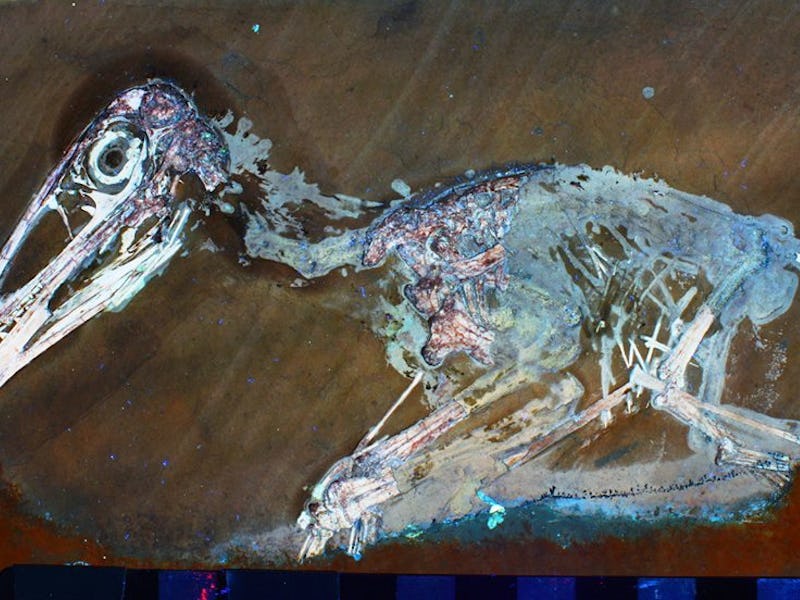What Did Dinosaurs Look Like? Tom Kaye Finds Answers, Feathers With Lasers
Preserved soft tissues, like feathers and skin, are fundamentally changing what we thought we knew about the dinosaurs.

Tom Kaye has figured out how to see fossils in a whole new light. He uses laser fluorescence to illuminate specimens and uncover evidence of soft tissue preservation that has never been seen before. He’s maybe the only person on Earth not named Sam Neill who can say he’s looked into the eyes of a pterosaur.
Kaye, who is currently on a tour of German museums to scan collections of fossils for new discoveries, describes his device as a “UV lamp on steroids,” and a “little laser-pointer-in-a-can gizmo.” Here’s how it works:
- Kaye shines a high-powered laser beam onto a fossil.
- Kaye waits for the photons from the laser to enter the atoms they encounter, interact with them, and then bounce back at a longer wavelength. This doesn’t take long.
- Kaye uses a long-exposure camera fitted with a filter to block the color of the laser to take a picture.
- Kaye looks over the picture, which renders chemical differences on the atomic level visible to the naked eye.
- Kaye moves on to the next fossil.
This method, which is cheaper and easier than many of the other ways used to investigate fossilized soft tissue, is showing some incredible results. “Because the laser is so intense, it brings out details that you can’t see by other methods,” says Kaye. “The bones glow like a lightbulb and the matrix that they’re buried in becomes black, so you can see the bones very vividly, and that’s helping us determine some very small features in the bones that are hard to see.”
The imaging method can pick up evidence of soft-tissues like skin, feathers, scales, and other elements, too. Take the pterosaur eye, for example. “Nothing that we’ve seen before preserves something that looks like an iris in there,” he says. “It’s a brand new discovery — less than 48 hours old. So we don’t know what to make of it yet. We have not see this before at this level.”
It will take a careful comb through the scientific literature to know for sure if anyone has seen anything like this before, and some careful analysis to say with some certainty if the fluorescence image is really showing what it appears to be showing.
That was an exciting find, but not as exciting as something that Kaye spotted in a fossilized feather — the feather for which the Archaeopteryx was named. What he saw in that fossil is so potentially important that he’s been tight-lipped about what exactly it is. But he’s giving some clues: He says he saw a feature in the fossil that was described in the original 1861 paper describing the specimen, but hasn’t been seen since, even with the most high-tech imaging equipment. It’s a paleontological riddle we couldn’t solve.
Kaye chose to travel to Germany because it has some of the best-preserved fossils on the planet. For centuries fossils have been discovered in the limestone quarries around Solnhofen, preserved in slabs of rock that reveal their contents when the rock it split apart. “Normally when we dig up a dinosaur, we dig all the dirt away from around the bones, so if there’s any (evidence of soft tissue) there it’s long gone. But when we find something on a slab, the slab is still intact.”
The fossils were formed by animals falling into a shallow sea and becoming buried in mud, which eventually turned to stone. Only a few sites in the world have produced fossils with this exceptional level of preservation.
For centuries, vertebrate paleontology has largely been about the study of bones. But in the last decade or two, new evidence of soft tissue preservation has really changed the field, and the way we think about dinosaurs. It’s not that every fossil has good soft-tissue preservation, says Kaye, but those that do have a lot to offer researchers. The discovery of feathers on the hind legs of winged dinosaurs, for example, dramatically changed how paleontologists pictured them. Now, the interpretation is that they would have flown less like the birds of today, and more like a four-winged gliders.
“When you see something like that, that changes your whole interpretation of what’s going on. It makes you think in completely new directions. So that’s the type of thing that’s changing.”
Paleontologists are starting to be more careful to examine the dirt around the bones before digging it away, for example by checking for soft-tissue preservation under UV light, says Kaye. One day, these fossilized soft tissues could help answer some of the most amazing paleontological mysteries, like how the feathered dinosaurs survived the great extinction, when all the rest did not.
“That is a very interesting question in my mind: What gave them the advantage there that other animals didn’t have?” says Kaye. “If I could answer that question I’d be a super famous paleontologist.”